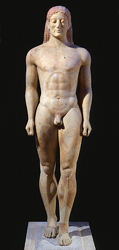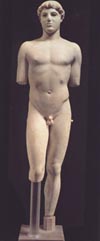Art
web | ARTH Home | ARTH
Courses | ARTH 109 | ARTH 109 Assignments | Forward | Back
| Contact
Arth 109
Early Classical Sculpture
Slide List 8

|

|
| Metropolitan Kouros, Early Archaic, c.
615-590 B.C. |
Kroisos (Kouros from Anavysos), c. 540-515
B.C. |

|
|
|
| Kritios Boy, from the Acropolis of Athens,
c. 480 B.C. 360 degree view of the Kritios Boy. |
|

Reconstruction of tbe Temple of Aphaia at Aegina.
|

Reconstruction of the pediment of the Temple of Aphaia at Aegina.
|

|

|
|
| Archer from the East Pediment of the Temple
of Aphaia at Aegina, c. 490-480 B.C. |
Archer from the west pediment of the Temple
of Aphaia at Aegina, c. 510 B.C. |
 
|

|
| Fallen Warrior from the East Pediment of
the Temple of Aphaia at Aegina, c. 490-480 B.C. |
Fallen Warrior from the West Pediment of
the Temple of Aphaia at Aegina, c. 510 B.C. |

|
|
| Polykleitos, Doryphoros, original c. 450-440
B.C., Roman copy. 360 degree view of the Doryphoros. |
|
| |
  
|
| |
Warrior from Riace, bronze, third quarter
of the 5th c. B.C. |
Term
Contrapposto- placed opposite. The disposition of the parts
of the body so that they turn along oblique axes around a central
vertical axis. The figure is "counterpoised" so that
the weight-bearing leg, or engaged leg, is distinguished from
the raised, or free leg, the resulting shift in the axes of hips
and shoulders is observed. Above all, the stiff frontality and
parallel alignments which are characteristic of Egyptian and Archaic
Greek sculpture are avoided, and the body is conceived of as an
organic mechanism composed of interdependent parts. Note
how in a work like the Kritios Boy the artist goes beyond the
observation of the shifting axes in the body to record the distinction
between tensed and relaxed muscles.
Question for Review

|

|
| Anavysos Kouros, c. 540-515 B.C. |
Kritios Boy, c. 480 B.C. |
Define the transformations that have taken place between the
sculpture of the late archaic period and that of the early Classical
period. Note how these imply a change in relationship of the viewer
to the work of art.
Quotation
In commenting upon the opinion of the Stoic philosopher Chrysippus
that health in the body is the result of the harmony of all its
constituent elements, the physician Galen (second century A.D.)
adds:
"Beauty resides not in the commensurability, but in the
commensurability of the parts, such as finger to finger, and of
all the fingers to the metacarpus and the wrist, and of these
to the forearm, and of the forearm to the arm, in fact of everything
to everything, as it is written in the Canon of Polykleitos.
For having taught us in that treatise all the symmetriae of the
body, Polykleitos supported this treatise with a work, having
made a statue of a man according to the tenets of his treatise,
and having called the statue itself, like the treatise, the Canon.
Art
web | ARTH
Home | ARTH Courses | ARTH 109 | ARTH
109 Assignments | Forward | Back | Contact









